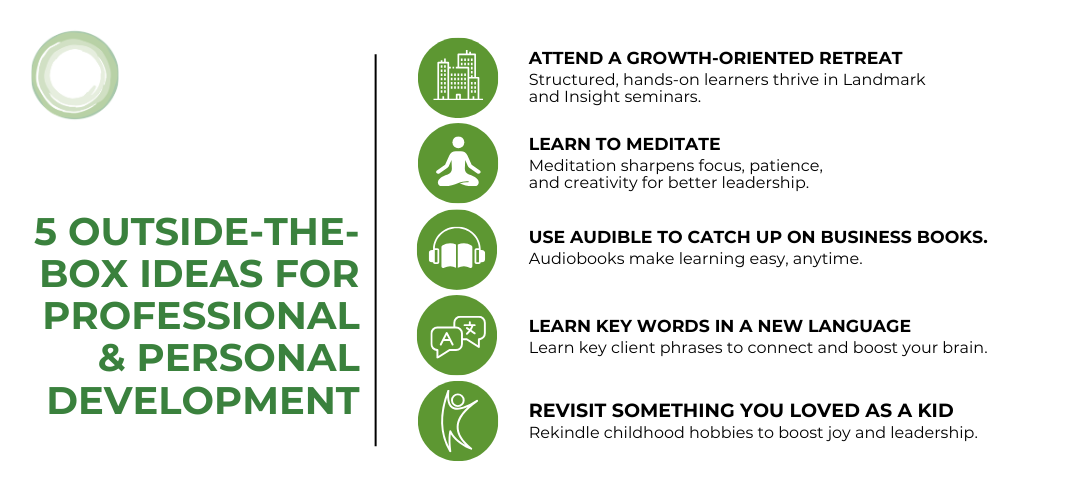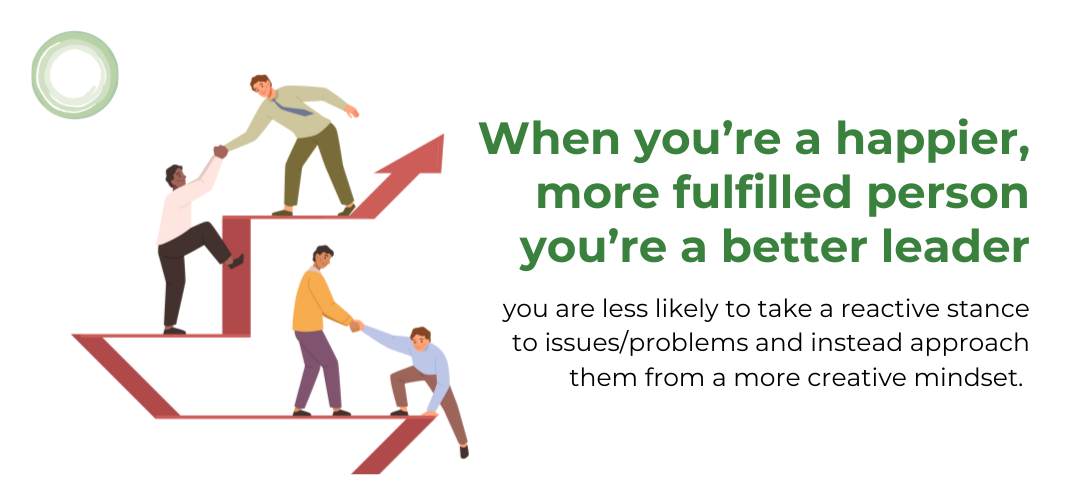No matter how long ago you graduated, the approach of September always has that back-to-school feel, doesn’t it?
Even if it’s been decades since I bought a Trapper Keeper or sat in homeroom, this time of year still makes me excited to learn new things.
You too? That’s great because a ‘growth mindset’ is one of the biggest indicators of success — in business and in life.
What’s a growth mindset? Dr. Carol Dweck, who coined the term, describes it this way: “In a growth mindset, people believe that their most basic abilities can be developed through dedication and exploration — brains and talent are just the starting point. This view creates a love of learning and a resilience that is essential for great accomplishment.”
If this time of year has you yearning to learn something new and test your abilities, read on!
5 Outside-The-Box Ideas For Professional & Personal Development

1. Attend a Leadership Development Retreat to Build Growth Mindset
Do you learn best in a structured environment? With projects and exercises and group discussions?
If that sounds like you, seminars and retreats are where you’ll learn best. For example, the Landmark Forum is grounded in a model of transformative learning — a way of learning that gives people an awareness of the basic structures in which they know, think and act. My journey to become a Leadership Coach started with Landmark over 17 years ago. Insight seminars are highly interactive and experiential for each and every participant. Participants learn through a series of short presentations, one-to-one exercises and lively group discussions. To deepen this kind of experiential learning, check out these insights on how to develop executive presence through leadership retreats.
Some of our favorite personal growth retreats are:
Interested in deeper leadership transformation? Our Leadership EDGE program blends experiential learning with strategic growth frameworks for teams and cohorts alike.
2. Use Meditation to Boost Focus, Emotional Intelligence, and Leadership Skills
If you’re wondering how meditation could possibly influence your career, hear me out!
Numerous studies have proven that meditation increases focus, patience and creativity — all traits of a great leader! I’ve written about this before, so see the 3rd bullet below for more information. Mindfulness practices like meditation are also a proven way to strengthen emotional intelligence in leadership.
How to get started with meditation:
- Calm app
- Headspace app
- Learn why meditation is better than caffeine
- Monday Meditations YouTube channel
- Learn to Meditate: A Practical Guide to Self-Discovery and Fulfillment
3. Use Audible for Ongoing Leadership and Professional Development
Do you have an entire shelf of business books gathering dust? When you’re busy leading a company and trying to maintain some semblance of work/life balance, it’s hard to find time to read.
Enter: Audible. I love it. Use this platform to listen to books on your commute, during flights or while you make dinner. I even listen in ten-minute snippets while I’m getting ready for bed!
Audiobooks make it so easy to learn new things, stay on top of changes in your industry or just catch up on that bestseller everyone’s talking about. Lack of time is no longer an excuse! If you’re seeking self-paced ways to grow professionally, here are self-guided leadership development strategies worth exploring.
Some of our favorite books to get you started:
- Dying to Be Me
- Thinking Fast and Slow
- Never Split the Difference: Negotiating As If Your Life Depended On It
- The Subtle Art of Not Giving a F*ck
4. Learn Key Phrases in a New Language to Strengthen Global Leadership Skills
Learning languages is so good for us. Learning a second language improves the functionality of your brain, improves your memory and staves off Alzheimer’s and dementia. Talk about a win/win/win!
But becoming truly fluent in a language is a multi-year process. So instead, I’m going to suggest that you learn 15 or 20 key words or phrases in a language spoken by your clients, vendors or team.
Your team members in Beijing will be so happy to hear you wish them “Happy Chinese New Year!” in Mandarin. Your vendor in Brazil will probably appreciate it when you greet her with “Tudo bem?”
These tiny efforts go a long way towards strengthening professional relationships, and they’re good for your brain.
Places to learn key phrases in a new language
- Google translate: You can just type in the phrase you want to learn, and it will say it back to you in the target language!
- Duolingo app
- Pimsleur
- RosettaStone
Looking to strengthen team dynamics across cultures? Try this quick quiz on team engagement to find out where your group thrives — and where there’s room to grow.
5. Reconnect with Childhood Passions to Fuel Personal Growth as a Leader
As we get older, it’s tempting to turn our attention exclusively towards activities that bring in money, business or prestige.
We take up golf because it facilitates networking, and we forget how much we used to love playing softball. We abandon our tango classes because what’s the point? That’s time we could be using to pitch investors or meet with potential clients.
I encourage you to revisit some of the things you loved as a kid. What did you like before you were concerned about an activity being monetizable or business expense-able?
Whatever you liked as a kid, there’s probably an adult version of it — and it probably still makes you happy. Join your company softball league! Do some community theater! Rent a mountain bike and see if you still love barreling down narrow dirt trails.
I recently started riding horses again — something I hadn’t done in years — and I was floored by how much I loved it. It helped me reconnect with myself in a way that’s not possible in the office or at workshops.
And how does this apply to your career? It’s about balance. When you’re a happier, more fulfilled person you’re a better leader — you are less likely to take a reactive stance to issues/problems and instead approach them from a more creative mindset. FUN is good for you.
Whether you’re leading a team or growing into a new role, our bespoke leadership development solutions are tailored to your challenges — from self-awareness to scaling performance.

Places to check out previously-loved interests
- Community rec sports leagues
- Your local YMCA and YWCA
- Community Ed.
- Skillshare, Udemy, or YouTube tutorials
- Meetup groups to find other people who are interested in the same stuff
If you’re not sure where to start with your professional development, we’d love to help! Contact us.


